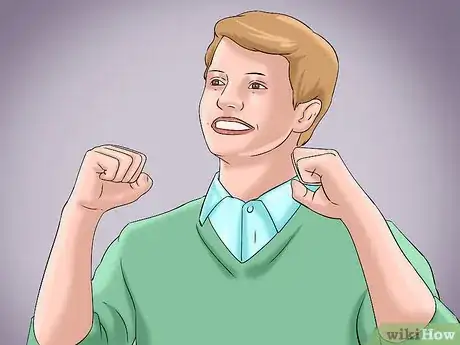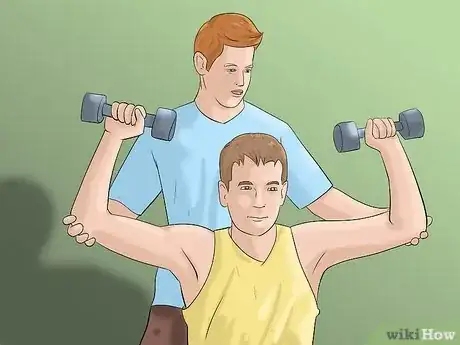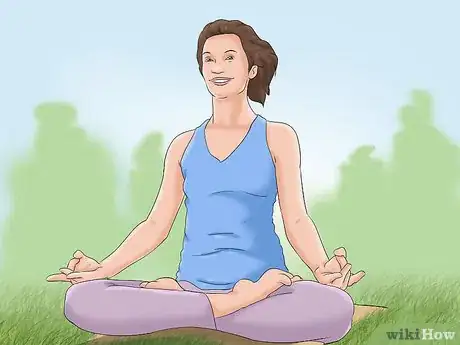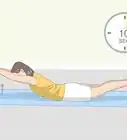This article was co-authored by Laila Ajani. Laila Ajani is a Fitness Trainer and founder of Push Personal Fitness, a personal training organization based in the San Francisco Bay Area. Laila has expertise in competitive athletics (gymnastics, powerlifting, and tennis), personal training, distance running, and Olympic lifting. Laila is certified by the National Strength & Conditioning Association (NSCA), USA Powerlifting (USAPL), and she is a Corrective Exercise Specialist (CES).
There are 11 references cited in this article, which can be found at the bottom of the page.
wikiHow marks an article as reader-approved once it receives enough positive feedback. In this case, 98% of readers who voted found the article helpful, earning it our reader-approved status.
This article has been viewed 101,879 times.
It is important to remain healthy and active throughout life, especially as you age. Staying fit can add years to your lifespan and will markedly improve your overall well-being. There are so many diet gurus and exercise regimens out there that staying fit can seem like a daunting task, but it is really quite simple if you stick to the basics. As a general rule, it takes about two months for a behavior to become a habit. Try making a few changes that you think you will be able to manage, and then stick to them for a couple of months until they become part of your natural routine.[1]
Steps
Staying Fit Through Exercise
-
1Motivate yourself by understanding the many benefits of exercise. When you have an especially busy week, or simply don't feel like working out, it might help to focus on the reasons you made the decision to get fit. Exercise not only controls weight, it helps fight disease, improves the immune system, and gives you more energy. Exercise also improves your mood and helps you sleep better.[2]
-
2Choose an activity you enjoy. Many people find that going to a gym several times a week is a convenient way to exercise, but there are many other ways to stay healthy and active. Running, walking, and swimming are all great ways to stay fit. You might also consider taking lessons for something you'd like to learn: dancing, surfing, or ice skating.[3] You can even get great exercise at home through consulting free online exercise videos.[4]Advertisement
-
3Devote some time to all four types of exercise. Pay attention to all the elements of total fitness, including endurance, strength, balance, and flexibility.[5]
- Try to build up gradually to at least 30 minutes of an activity that makes you breathe hard.[6] Your goal should be 150 minutes of moderate-intensity exercise a week, or 30 minutes five times a week.[7]
- Lift weights to improve muscle tone. Keeping your muscles in shape will make your daily tasks easier to manage, and will help you avoid problems later in life, such as a broken hip caused by a fall.[8]
- Improving your balance will also help you avoid dangerous falls later in life, and will allow you to remain active and mobile throughout your life. One easy exercise is to walk in a straight line, placing the heel of one foot directly in front of the toe of the other as if you were crossing a river on a slender beam.[9]
- Regular stretching exercises will improve your overall flexibility, making it easier to bend to tie your shoes or to reach something on a high shelf. Be sure to stretch your muscles gently, to avoid injury.[10]
-
4Enlist the help of a friend. Having an “exercise buddy” will help you both to stay motivated, and will make your workout time more enjoyable. For a fun weekend activity, get some friends together to play basketball, softball, volleyball, or tennis.[11]
-
5Set realistic goals. Setting goals for yourself will help keep you motivated, and meeting your goal milestones will give you a wonderful boost of confidence and a feeling of accomplishment; however, be sure to break your overall goals down into small, manageable steps, so you won't become discouraged.[12]
-
6Work with your body's natural clock. It isn't necessary to work out first thing in the morning, if you are not a morning person. If you feel most active in the afternoon, schedule your workouts for the afternoon hours.[13]
-
7Consult a pro. If you aren't sure where to start, enlist the help of a professional fitness trainer. Some gyms offer free consultation with a fitness trainer as part of your enrollment fee. If you don't belong to a gym, seek out an independent trainer to work with you. A trainer will assess your strengths and weaknesses, and suggest a regimen that will achieve your particular fitness goals.[14]
Maintaining a Healthy Diet
-
1Limit packaged foods. Most pre-packaged foods have unnatural chemical additives and preservatives, and often contain unhealthy saturated or trans fat. It is almost always better to eat food you prepare at home, where you can control the ingredients.[15] Most pre-packaged foods are also higher in calories and fat, especially saturated trans fats.[16]
-
2Watch those portion sizes. Dieticians recommend eating slowly, which helps you recognize when you are full. When you continue to eat after your hunger has been satisfied, you are ingesting a lot of calories that easily could have been avoided.[17] Limit calories to 2,000 kcal/day. If you are trying to lose weight, try cutting down to 1,800 kcal/day. Never consume fewer than 1,200 kcal/day.
- One serving of meat, fish, or poultry should be about 3 ounces, when cooked, or about the same size as the palm of your hand.[18]
- A serving of cooked pasta should be about half a cup, or roughly the size of a scoop of ice cream.
- One serving of grains is equal to one slice of bread. One pancake or one waffle equals one serving, which should be about the same size as a typical slice of bread.
- One cubed serving of cheese is roughly the same size as your entire thumb.
- One serving of vegetables or fruit is about the size of your fist.
- A healthy serving size of cooked rice is about enough to fill a standard cupcake wrapper.
- Try to make half of your plate consist of vegetables.
-
3Share an entree. Restaurants often serve food in unusually large portions. Sharing one entree between two people is a good way to ensure proper portion size and save money as well.[19]
-
4Eat less meat. Although it is not imperative to eliminate meat from your diet entirely, reducing the amount you eat will have a positive effect on your health. Many meats are high in calories and contain a large percentage of fat. Red meats especially have been linked to clogged arteries, higher cholesterol, and heart problems.[20]
-
5Eat more whole grains. Oatmeal, brown rice, and whole-wheat bread contain fiber, which is essential to a healthy digestive tract. Whole grains also contain B vitamins, which boost energy and metabolism.[21]
-
6Snack on nuts, seeds, and legumes. Nuts and seeds contain vitamin E and other nutrients that aren't readily found in other foods. Legumes such as peanuts, lentils, beans, and soybeans also provide fiber, as well as protein, iron, folate, and other important nutrients.[22]
-
7Limit saturated and trans fats. A lot of heart disease deaths comes from these 2 fats. Saturated and trans fats. Saturated and trans fats raise your bad cholesterol and lower the good cholesterol. You should limit saturated fat to less that 10% of your daily calories. For a 1500 calorie diet that would be 15g, for a 2000 calorie diet that would be 20g. You should limit trans fats to less than 1% of your daily calories. For a 1500 calorie diet that would be 1.5g, for a 2000 calorie diet that would be 2g. Consuming trans fats increase the risk of heart disease by 46% every 4% of your daily calories from trans fats.
-
8Limit processed food. Foods such as pizza and cake have little vitamins and lots of calories. Processed food increase body fat which can cause obesity. Processed food has tons of saturated fat and sometimes trans fat. Processed food cause diabetes and heart disease. Replace processed food with unsaturated fats, whole grains and fruits and vegetables.
Changing Your Daily Routines
-
1Spend more time outdoors. Whenever possible, try to spend at least 30 minutes per day outside enjoying the sunlight. Exposure to sunlight triggers the production of Vitamin D, which helps improve your immune system function and strengthen your bones. The sun's rays also increase levels of serotonin in the body, which promotes feelings of well-being and happiness, and helps to regulate your appetite.[23]
-
2Make small changes in your daily routine. The accumulated effects of making numerous minor changes will go a long way in helping you become a healthy, active person overall.
- Avoid the easy way. Try taking the stairs instead of the elevator, and walk through your golf game instead of driving a cart.[24]
- Park farther from the door when you are out shopping. This small change will add to the accumulated number of steps you take per day, and it might also free up a parking space for a less agile person who needs it more.[25]
- Wash your car by hand instead of using the drive-thru. This can be a fun activity when the weather is nice, and hand-washing is much gentler on your paint than the big mechanical brushes.[26]
- Walk or ride to work. If you live close enough to your place of employment, walking or riding a bicycle to and from work is a great way to stay in shape.
- Take a lunchtime walk. Taking a long walk on your lunch hour can be an enjoyable way to refresh your mind and your body. Try inviting a friend along![27]
-
3Drink lots of water. One of the most important elements of any healthy diet is water. Try to drink around eight 8-ounce glasses of water per day, to keep your body hydrated and to avoid potential health problems. Also, water will help you feel full so you will eat less. If you don't like plain water, try adding fruit, herbal tea, or sugar-free flavoring. There are also apps like Waterlogged that will remind you to drink more water![28]
-
4Wake up earlier. For two weeks, try setting your alarm clock to wake up 30 minutes earlier than your usual time. Having that extra half hour will eliminate a lot of stress caused by rushing around in the morning, and can also make you feel more responsible and empowered.[29]
-
5Try meditation. Just twenty minutes per day has been shown help reduce stress, lower blood pressure, and generate feelings of happiness and well-being. Simply find a quiet place where you will not be disturbed, and sit comfortably with your hands resting, palms-up, gently on your knees. Focus on your breathing, which should be regular and deep, and try to clear your mind.[30]
- Try candle meditation. If you find that your mind wanders when you try to meditate, you might try lighting a candle, and focusing on the flame.[31]
- Make use of mantras. Some people find it helps to repeat a word over and over. You can use a traditional Sanskrit mantra, or use any word that has positive associations for you.[32]
- Practice creative visualization. Another easy technique is to imagine yourself in a peaceful, beautiful location. Imagine all the small details of the setting, and ignore everything in the physical world around you.[33]
Expert Q&A
-
QuestionWhy won't my biceps grow?
 Laila AjaniLaila Ajani is a Fitness Trainer and founder of Push Personal Fitness, a personal training organization based in the San Francisco Bay Area. Laila has expertise in competitive athletics (gymnastics, powerlifting, and tennis), personal training, distance running, and Olympic lifting. Laila is certified by the National Strength & Conditioning Association (NSCA), USA Powerlifting (USAPL), and she is a Corrective Exercise Specialist (CES).
Laila AjaniLaila Ajani is a Fitness Trainer and founder of Push Personal Fitness, a personal training organization based in the San Francisco Bay Area. Laila has expertise in competitive athletics (gymnastics, powerlifting, and tennis), personal training, distance running, and Olympic lifting. Laila is certified by the National Strength & Conditioning Association (NSCA), USA Powerlifting (USAPL), and she is a Corrective Exercise Specialist (CES).
Fitness Trainer
-
QuestionWhat is a simple exercise routine to stay fit?
 Laila AjaniLaila Ajani is a Fitness Trainer and founder of Push Personal Fitness, a personal training organization based in the San Francisco Bay Area. Laila has expertise in competitive athletics (gymnastics, powerlifting, and tennis), personal training, distance running, and Olympic lifting. Laila is certified by the National Strength & Conditioning Association (NSCA), USA Powerlifting (USAPL), and she is a Corrective Exercise Specialist (CES).
Laila AjaniLaila Ajani is a Fitness Trainer and founder of Push Personal Fitness, a personal training organization based in the San Francisco Bay Area. Laila has expertise in competitive athletics (gymnastics, powerlifting, and tennis), personal training, distance running, and Olympic lifting. Laila is certified by the National Strength & Conditioning Association (NSCA), USA Powerlifting (USAPL), and she is a Corrective Exercise Specialist (CES).
Fitness Trainer A really good way to set up a routine is to have three days that you allot for just strength training and another three days for something that gets your heart rate up like going for a jog or taking a bike ride. I would recommend exercising for 30 minutes each time, six days a week. You can also build in a rest day so that you're giving your body some time off.
A really good way to set up a routine is to have three days that you allot for just strength training and another three days for something that gets your heart rate up like going for a jog or taking a bike ride. I would recommend exercising for 30 minutes each time, six days a week. You can also build in a rest day so that you're giving your body some time off.
Warnings
- Always consult with your doctor before beginning any exercise regimen.⧼thumbs_response⧽
References
- ↑ Laila Ajani. Fitness Trainer. Expert Interview. 31 October 2019.
- ↑ http://www.mayoclinic.org/healthy-lifestyle/fitness/in-depth/exercise/art-20048389
- ↑ http://www.mayoclinic.org/healthy-lifestyle/fitness/in-depth/exercise/art-20048389
- ↑ Laila Ajani. Fitness Trainer. Expert Interview. 31 October 2019.
- ↑ https://www.nia.nih.gov/health/publication/exercise-and-physical-activity
- ↑ Laila Ajani. Fitness Trainer. Expert Interview. 31 October 2019.
- ↑ https://www.nia.nih.gov/health/publication/exercise-and-physical-activity
- ↑ https://www.nia.nih.gov/health/publication/exercise-and-physical-activity
- ↑ https://www.nia.nih.gov/health/publication/exercise-and-physical-activity
- ↑ https://www.nia.nih.gov/health/publication/exercise-and-physical-activity
- ↑ http://www.webmd.com/fitness-exercise/guide/10-workout-secrets-expert-exercise-tips
- ↑ http://www.webmd.com/fitness-exercise/guide/10-workout-secrets-expert-exercise-tips
- ↑ http://www.webmd.com/fitness-exercise/guide/10-workout-secrets-expert-exercise-tips
- ↑ http://www.webmd.com/fitness-exercise/guide/10-workout-secrets-expert-exercise-tips
- ↑ Laila Ajani. Fitness Trainer. Expert Interview. 31 October 2019.
- ↑ http://www.realsimple.com/health/nutrition-diet/healthy-eating/7-principles-healthy-eating/page3
- ↑ http://www.webmd.com/diet/control-portion-size
- ↑ http://www.webmd.com/diet/control-portion-size
- ↑ http://www.realsimple.com/health/nutrition-diet/healthy-eating/7-principles-healthy-eating/page3
- ↑ http://www.realsimple.com/health/nutrition-diet/healthy-eating/7-principles-healthy-eating/page3
- ↑ http://www.realsimple.com/health/nutrition-diet/healthy-eating/7-principles-healthy-eating/page3
- ↑ http://www.realsimple.com/health/nutrition-diet/healthy-eating/7-principles-healthy-eating/page3
- ↑ http://www.theactivetimes.com/11-health-benefits-sunshine
- ↑ https://www.acefitness.org/fitfacts/pdfs/fitfacts/itemid_3577.pdf
- ↑ https://www.acefitness.org/fitfacts/pdfs/fitfacts/itemid_3577.pdf
- ↑ https://www.acefitness.org/fitfacts/pdfs/fitfacts/itemid_3577.pdf
- ↑ https://www.acefitness.org/fitfacts/pdfs/fitfacts/itemid_3577.pdf
- ↑ http://www.webmd.com/fitness-exercise/guide/10-workout-secrets-expert-exercise-tips?page=2
- ↑ http://www.webmd.com/fitness-exercise/guide/10-workout-secrets-expert-exercise-tips?page=2
- ↑ http://www.webmd.com/balance/features/meditation-heals-body-and-mind?page=2
- ↑ http://www.mindbodygreen.com/0-16452/6-simple-meditation-techniques-for-real-people.html
- ↑ http://www.mindbodygreen.com/0-16452/6-simple-meditation-techniques-for-real-people.html
- ↑ http://www.mindbodygreen.com/0-16452/6-simple-meditation-techniques-for-real-people.html
About This Article
To stay healthy and active, try to eat as many fresh foods as possible, such as fruits, vegetables, meat, and fish, since they have little to no unnatural additives and preservatives. You should also try to eat more whole grains, like oatmeal, brown rice, and whole-wheat bread, which are high in vitamin B and fiber. As well as eating a healthy diet, you should also try to exercise for 30 minutes five times a week to keep your body in shape. Try to find activities that you enjoy, like running, swimming, or dancing, since you'll be more likely to stick with them. You can also find a friend to exercise or play ball games with to make it more enjoyable. For more tips from our Medical co-author, including how to plan a daily routine to help you eat and exercise better, read on!





-Step-3.webp)
-Step-4.webp)










-Step-5-Version-3.webp)




























































